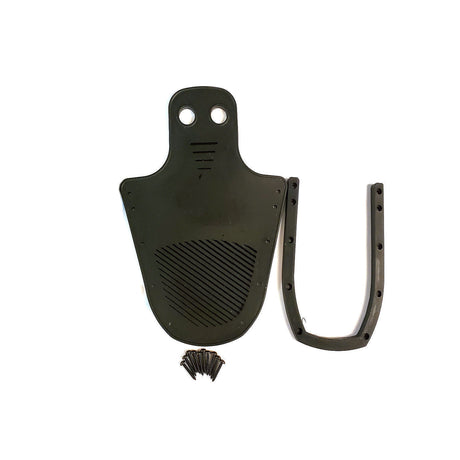Water skiing is an exhilarating sport that combines the thrill of speed with the beauty of gliding across the water. To fully enjoy this activity, it is essential to have the right equipment, including the proper water ski ropes and handles. In this guide, we will explore everything you need to know about these crucial components of water skiing.
Types of Water Ski Ropes
Water ski ropes come in various types, each designed for specific purposes. The most common types include:
Recreational Ropes

Pictured: Proline Air 75' Recreational Waterski Rope & Handle
Recreational ski ropes are considered standard ropes, and they're used by most riders. Standard ski ropes measure 75 feet: 70 feet of single rope attaches to the handle's split rope, which measures 5 feet.
Standard ropes can also be adjusted in length, with some rope available in 8 to 10 sections to reduce the length as preferred by the rider.
Recreational rope is made to be stretchy. This reduces shock to the rider's arms from the force of the boat's pull. To provide extra stretch, recreational ropes are often made from polyethylene, also called PE, but some are made from polypropylene (often called "Poly P") that isn't pre-stretched.
Tournament Ropes

Pictured: Radar Control Pro Waterski Rope & Handle
Tournament ropes are used almost exclusively by slalom skiers and professional riders. These ropes are shorter, measuring 60 feet -- the standard length for a slalom ski course.
Tournament ropes have less stretch, as they come pre-stretched to ensure consistent performance. These ropes are made from polypropylene.
Trick Ropes
Trick ropes are designed for performing tricks and jumps. They are shorter and have a smaller diameter, allowing for quick spins and rotations.
Trick ropes measure 45 to 50 feet, with up to 4 adjustable-length sections measuring between 1.5 and 3 feet provided to make the line even shorter. Trick ropes can be made from low-stretch PE or no-stretch Poly P.
(Slalom and Combo Ski Rope is The Same)
Although shorter tournament ropes are made for slalom course skiers, recreational (standard) ropes are made to be used by combo and slalom skiers in open water.
New to water skiing? Read our guide on combo skis vs slalom skis.
Polypropylene vs Polyethylene Rope
Like we mentioned, polypropylene ski rope (often branded as "Spectra" or "Dyneema") is used for high-performance skiing, where minimal stretch is desired. These ropes provide more responsiveness and control, but they can fatigue the arms faster by introducing more shock from being pulled.
New skiers can even suffer injury from fast starts in the water while holding Poly P rope, so it's best to start off with stretchier line.
That's where polyethylene rope comes in. It's more forgiving and reduces shock and strain on the rider's arms. The tradeoff is less responsiveness and slower reactions when turning, but it's more than suitable even for advanced recreational skiers.
Picking a Water Ski Handle
Whether you're riding combo or slalom, your ski handle will consist of a handle bar measuring 11" to 13" in length and about 0.9" to 1.1" in diameter, with the handle rope forming a "Y" section that attaches to either end of the bar. Bars are covered with soft foam, or tacky rubber.
"Which handle material's better?"
Foam handles provide more comfort and are suitable for bare hands when skiing for recreation. Rubberized handle bars are typically reserved for slalom skiers looking for added grip and performance. Skiers using rubber handle bars also usually wear tournament gloves.

Handle Rope Y Section
When it comes to picking the right ski handle, the biggest consideration lies in how the line attaches to the handle. Some handles have short Y sections of rope, while others have longer Y sections.
The longer the Y, the easier deep-water starts will be for beginner skiers. This is because the longer split section of rope provides better control, stability, and balance as the rider moves to get up and riding.
But a long Y section isn't universally better. A shorter section reduces handle roll once you're up and moving, and it provides better responsiveness and more consistent pulling power once you're at speed behind the boat.
Soft Line vs. Hard Anti-Roll Bars
Take another look at the two ski handles above, and you'll notice one handle (the HO 41 Tail) has a soft Y section of rope attaching to the handle bar, while the other handle (the Masterline 5-Section Mainline) has hard bars that form most of the rope's Y section.
These are anti-roll bars. They provide even more anti-roll stability while also improving control at speed, providing the benefits of a longer Y section without the drawbacks.
How to care for your ski rope and handle
To ensure the longevity of your water ski rope and handle, follow these care tips:
- After each use, rinse the rope and handle with fresh water to remove any salt or debris.
- Avoid exposing the rope and handle to direct sunlight for extended periods, as it can weaken the material.
- Store the rope and handle in a cool, dry place to prevent mold or mildew growth.
- Inspect the rope and handle regularly for any signs of wear or damage. Replace them if necessary to maintain safety.
By understanding the different types of water ski ropes, considering the important factors when choosing one, and properly caring for your equipment, you can enhance your water skiing experience and ensure your safety on the water.
Now that you know what to look for in a water ski rope and handle, check out our collection of kits.












